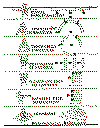A certain amount of drill is necessary for getting the Troop and Patrols into position for various activities and for moving the Troop with a semblance of order and smartness.
For this Scouting does not resort to military drill, but has developed its own technique, easily learned and considered by the boys as a game rather than a drill.
Main Features of Scout Drill
The main features of Scout drill are:
1. Alert Signal--In the Out-of-Doors: The Troop's special bird or animal call. In the Troop meeting room the leader raises his right hand in the Scout Sign high above his head, indicating "Attention," "Silence," "I have an announcement to make." If a formation is to follow, the leader takes a position, before making alert signal, facing the center of the formation he is going to call.
2. "Freezing" that is, becoming instantly immovable, or "frozen," on the alert signal. As soon as a Scout notices the sign, he stops what he is doing and puts up his hand in the same way. When everybody is making the sign, the leader lowers his hand. So do the boys and wait for the signal to follow.
3. Arm Signal by the leader indicating formation to be taken. This signal is held until all have fallen in.
4. The Troop Falls Into Position on the run, its center opposite the leader. The Patrol Leaders must be first in place since they are the key men of their Patrols' positions, The flanks of the formation should pick up their dressing automatically from the center. The Scouts stand at ease. It is necessary to establish a definite arrangement of the Patrols, so that each of them knows where to fall in.
5. The only Word-of-Mouth commands necessary are
| "Troop Atten ... tion!" | |
| "Troop at ... Ease!" | |
| "Scout Sign!" | |
| "Scout Salute!" | |
| "Hands ... Down!" or "Two!" |
and even these may be substituted by silent signals invented by the Troop.
Formations
INFORMAL ASSEMBLY:
| Signal: ("Come here") Leader swings his extended right arm in a small circle over his. Scouts rush toward him. |
SINGLE RANK FORMATION (TROOP LINE):
| Signal: Leader extends both arms horizontally, parallel to the line he wishes Troop to take (with his palm turned front if he wants Patrols in front of him; with palm turned back if he wants Patrols behind him). | |
| Execution: Patrol Leaders take up position in front of the center of their Patrols. Patrols fall in line two paces behind their leaders, with a two-pace interval between Patrols. Assistant Patrol Leader is on right of Patrol, the other members on his left in order of sequence established by the Patrol. The line dresses right without command. | |
| Uses: For general line-up. For inspection in meeting room. |
COUNCIL OR "U" FORMATION (HORSESHOE):
| Signal: Leader raises arms from the sides, sideways about 45 degrees, palms toward the body. | |
| Execution: Scouts fall in, in a single line semi-circle around leader. Patrols observe same order of sequence as in Troop Line, though Patrol Leaders fall in on the right of their Patrols. | |
| Uses: For demonstrations, announcements or special ceremonies. |
TROOP CIRCLE FORMATION:
| Signal: Leader raises arms sideways 45 degrees, then swings them from front to rear and back several times. | |
| Execution: Patrols form a complete circle around the leader in same order as in Troop line. | |
| Uses: For ceremonies and circle games. |
OPEN COLUMN OF PATROLS:
| Signal: Leader extends arms forward, but bent at right angles at elbows, with fingers toward the sky. | |
| Execution: Patrols fall in, one behind the other, dressing immediately on the front Patrol and on the right. A distance equal to the length of each Patrol should be left between it and the Patrol in front of it. Patrol Leader two paces in front of the center of his Patrol. | |
| Uses: For inspection and parade formation: |
CLOSE COLUMN OF PATROLS:
| Signal: Same as for Open Column of Patrols, except that clenched lists are extended toward the sky. | |
| Execution: Similar to Open Column of Patrols, except that each Patrol falls in two paces behind the one in front of it, with the Patrol Leader on the right of his Patrol. | |
| Uses: For assembly in small room and crowded parade formation. |
PARALLEL FILE FORMATION (PATROL FILES):
| Signal: Arms extended forward at shoulder height, palms together. | |
| Execution: Patrol Leaders take positions two paces apart, their Scouts fall in behind them. | |
| Uses: For relays and other games. |
DISMISSAL:
| Signal: Swinging arms from a crossed-front position, repeated several times. |
Movements
Movements of the Troop are usually made from The Column formations. The leader turns around, and precedes the Patrols throughout the movements.
MOVE FORWARD (FORWARD MARCH!:
| Signal: Right arm raised vertically, then moved forward into horizontal position. |
TURN RIGHT OR LEFT (COLUMN RIGHT OR LEFT):
| Signal: Right (or left) arm extended right (or left) at Shoulder height. |
HALT:
| Signal: Hand, palm front, thrust upward from shoulder height to full extent of arm. |
